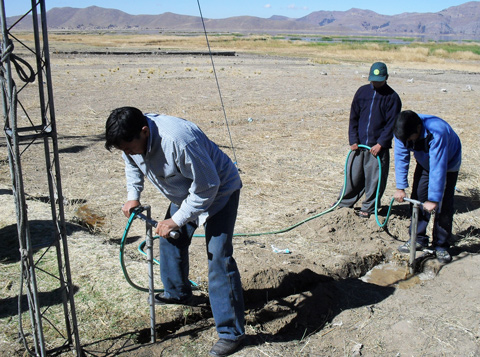Solution of the week 10
Drilling boreholes in the kitchen, the story of Samuel and Hermelinda
I spend October 2009 doing a super-intensive water and sanitation course in Bolivia, organised by the Mobile School for Water and Sanitation, EMAS. There, I met Samuel Ito Cartajena, aged 39, and his wife Hermelinda Yapanqui de Ito. Together with their 16 year-old daugher, they live in Juliaca, a city in the Puno region in southern Peru. Samuel was one of our teachers, and Hermelinda cooked for the twenty of us. This is their story.
Together, Samuel and Hermelinda share a small manual drilling enterprise. As Samuel explains, “We drill boreholes, make solar water heating systems, and install other water systems. In the city in which we live, usually water comes out of the tap only 2 hours per day. So people really like to have a well of their own. When we install a well somewhere, and friends or family of the owner of the well see it, they often also want one. This is how we get more business.”
2000 wells
“We drill boreholes by hand in the city, up to 28 meters deep. A well costs about 250 US$. We usually work with 4 to 5 people, and we rotate between lifting the drill stem and pumping the mud. Personally, I have drilled some 2000 wells, both in Peru and Bolivia.”
“Usually, we work in the city, but sometimes we have projects in the campo (rural areas) as well. When Alberto Fujimori was president of Peru, he initiated a large project to improve the water situation in rural villages. I participated in that project by assembling and training five drilling teams, and in total all five teams drilled 1500 wells in three years’ time. A properly drilled borehole lasts decades, gives water of high quality, and is a lot cheaper than machine-drilled wells.”
“I started working in the drilling business in 1992, when I worked with the Peruvian organization ADRA-OFASA. We drilled wells with large machines there. In 1997, while doing a project for the Bolivian organization OPS, I met a Dutch engineer called Pieter, who new Wolfgang Buchner who was working with the EMAS drilling system. Pieter arranged an invitation for me for a one-month course at EMAS, in well drilling, water tanks, and solar home heating. Shortly after that course, I started my own drilling enterprise, together with my wife, Hermelinda.”
Drilling in kitchens and bathrooms
Hermelinda: “We have worked together since the beginning, and we also followed the EMAS training course together. The EMAS technology is very flexible, and it allows us to drill in small spaces such as people’s kitchens and bathrooms. But because we don’t use a drilling tower, we cannot go deeper than 28 meters. And the work is quite heavy, we have to move the drill stem and pump the drilling mud ourselves.”
“In other cities where we would like to work, the water level can be as deep as 60 meters, and for that you need a machine. In the future, we would like to expand our drilling enterprise to also work with machines, to be able to drill more wells, but also to avoid some of the heavy work. But even a small drilling machine can cost up to 80.000 US$, and this is very expensive for us. A complete drilling set for EMAS costs about 800$. But there is a lot of demand for wells, so we are positive about the future.”
“In Peru, drilling is a man’s job, and many people think it is strange that I drill wells. But I am happy with my job and I don’t care what people say, because Samuel and I provide others with clean water. We believe everybody should have clean water — que tengan agua pura.”


